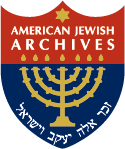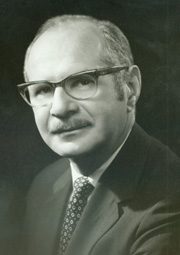TABLE OF CONTENTS
Series A. Sermons and Public Talks. 1930-1998.
Series B. Chaplaincy. 1933-1974.
Series C. World Union for Progressive Judaism. 1961-1987.
Series D. Union of American Hebrew Congregations. 1981-1987.

A Finding Aid to the Harold I. Saperstein Papers. 1930-1998. (bulk 1940-1970).
Manuscript Collection No. 718
Introduction |
|
| Repository: | The Jacob Rader Marcus Center of the American Jewish Archives |
| Creator: | Saperstein, Harold, 1910-2001 |
| Title: | Harold I. Saperstein Papers |
| Dates: | 1930-1998 |
| Bulk Dates: | 1940-1970 |
| Quantity: | 5.8 linear ft. (15 Hollinger boxes) |
| Abstract: | The Harold I. Saperstein Papers contain sermons, writings, correspondence and nearprint materials reflecting his career as a congregational rabbi at Temple Emanu-El (Lynbrook, N.Y.), his work as a Jewish chaplain during World War II, and his active participation in the Reform movement. |
| Collection Number: | MS-718 |
| Language: | Collection material in English and Hebrew. |
Biographical Sketch

Harold I. Saperstein was born December 9th, 1910, in Troy, N.Y. He was the grandson of Hyman Lasker, a famed Orthodox Rabbi in Troy for forty years. He received an A.B. degree from Cornell University in 1931, where he was Phi Beta Kappa (Junior Year). He was ordained by the Jewish Institute of Religion in 1935, where he studied closely with Rabbi Stephen S. Wise, and received the Guggenheimer Fellowship in his graduation year.
In 1933, at 22 years of age, Rabbi Saperstein began serving Temple Emanu-El of Lynbrook, New York. He served for nearly half a century before retiring in 1980. Even after retirement he often returned to speak at Lynbrook. During his time there the number of families grew from 80 in 1933 to more than 800 by the mid-1970s. He also served in a few temporary rabbinical positions. He served two six-month terms at the West London Synagogue of British Jews, for a year as interim rabbi at the Central Synagogue of New York, and for a year and a half at New York’s Rodeph Sholom.
Rabbi Saperstein was also an army chaplain from 1943 until 1946. He received training at a chaplaincy school run by the Army at Harvard University, and then served stateside at Fort Banks, Massachusetts. In the spring of 1944, he was sent to Italy and served with the 2nd Replacement Depot, which provided combat replacements to frontline units. Saperstein stayed with the 2nd Replacement Depot as it moved from “somewhere in Italy” (due to army censorship he could often not be more specific in his letters) to “somewhere in France” until finally reaching “somewhere in Germany.” As well as serving the spiritual needs of his men, a majority of whom were not Jewish, he was instrumental in saving many relics of the Jewish community in Worms. At his final station in Namur, Belgium, he met with the local Catholic priest, Vicar Andre, who had saved over 200 Jewish lives during the Holocaust.
Saperstein was active and influential in the Reform movement in both the United States and worldwide. During his retirement he served the Union of American Hebrew Congregations as a “circuit rider.” He and his wife Marcia traveled throughout the Southwest, Southeast, and Midwest to speak at smaller congregations to support U.S. Reform Judaism. Globally, he was a delegate to conferences of the World Union for Progressive Judaism in 1953 and 1959. He was on the American Board of the World Union from 1967-1973 and presided over several meetings of the board.
He was an ardent Zionist and was a delegate to the World Zionist Congress in Geneva. He visited Israel many times during his lifetime, including during the 1967 Six-Day War, and was one of the first to visit the Old City and the Western Wall shortly after it fell to the Israeli Army.
Harold I. Saperstein died in 2001. He was survived by his wife Marcia, his two sons, Rabbi Marc Saperstein and Rabbi David Saperstein, and his daughter Sandy.
Scope and Content Note
Rabbi Harold Saperstein (1910-2001) was a congregational rabbi, wartime chaplain, and leader in the Reform movement, who was interested in a wide variety of social, political, and Jewish causes. One of the most interesting sections of these papers is Series B. Chaplaincy. This series contains records of correspondence between Saperstein and soldiers, families, and even war refugees. Also of interest are two leather-bound address books entitled Chapel Friends, containing contact information for U.S. soldiers Saperstein served. There is also a collection of contact information for soldiers’ families written on index cards. Information is also contained about Saperstein’s efforts to preserve Jewish history in the German city of Worms, and recounts of the encounter between Saperstein and Vicar Andre of Namur, Belgium, who hid Jews during the Holocaust.
His papers also contain sermons he delivered for over fifty years, usually at Temple Emanu-El in Lynbrook, N.Y. The topics of these sermons range from the issues about the Great Depression and the threat of Nazism in the 1930’s, to the death of President John F. Kennedy and the Reverend Martin Luther King Jr., to the struggles of Israel with attention paid to the 1967 and 1973 wars, and to the issues raised by the civil rights movement and the Vietnam War in the 1960’s and 1970’s.
The collection includes Saperstein’s records related to the World Union for Progressive Judaism. Included are transcripts of meetings of the North American Board in the 1960’s and 1970’s, information and reports received during World Union conventions held overseas, and clippings of booklets of material printed by the World Union.
Also included are files pertaining to Rabbi Saperstein’s work as a ‘circuit rider’ for the Union of American Hebrew Congregations in the 1980s, visiting congregations across the country on behalf of the UAHC. These files include reports on the congregations he visited, correspondence and publicity concerning his visits, together with budgets, itineraries, and other administrative materials.
Arrangement Note
This collection is arranged in five (5) series:
- Series A. Sermons and Public Talks. 1930-1998.
- Series B. Chaplaincy. 1933-1974.
- Series C. World Union for Progressive Judaism. 1961-1987.
- Series D. Union of American Hebrew Congregations. 1981-1987.
- Series E. Miscellaneous. 1984, undated.
Conditions of Access and Use
Terms of Access and Use
The Harold I. Saperstein Papers are open to all users. The original manuscript collection is available in the Barrows-Loebelson Reading Room of the Jacob Rader Marcus Center of the American Jewish Archives.
Property and Literary Rights
Marc and David Saperstein, by the act of donating this collection to the American Jewish Archives, assigned all property rights to the American Jewish Archives. Literary rights to the collection have been dedicated to the American Jewish Archives.
Questions concerning rights should be addressed to the Executive Director of the American Jewish Archives. For more information see the American Jewish Archives copyright information webpage.
Related Material
Related Collections
Saperstein, Harold, 1910-2001. Photographs. PC-4976.
Saperstein, Harold, 1910-2001. Nearprint biographies.
Administrative Information
Preferred Citation
Footnotes and bibliographic references should refer to the Harold I. Saperstein Papers and the American Jewish Archives. A suggestion for at least the first citation is as follows:
[Description], [Date], Box #, Folder #. MS-718. Harold I. Saperstein Papers. American Jewish Archives, Cincinnati, Ohio.
Provenance
The Harold I. Saperstein Papers were received from Rabbi Marc Saperstein and Rabbi David Saperstein in 2004.
Processing Information
Processed by David Greenberg, June 2005. Additional processing by Kevin Proffitt, December 2011.
Box and Folder Listing
Search Terms
The following terms have been used to index the description of this collection in the AJA's online catalog.